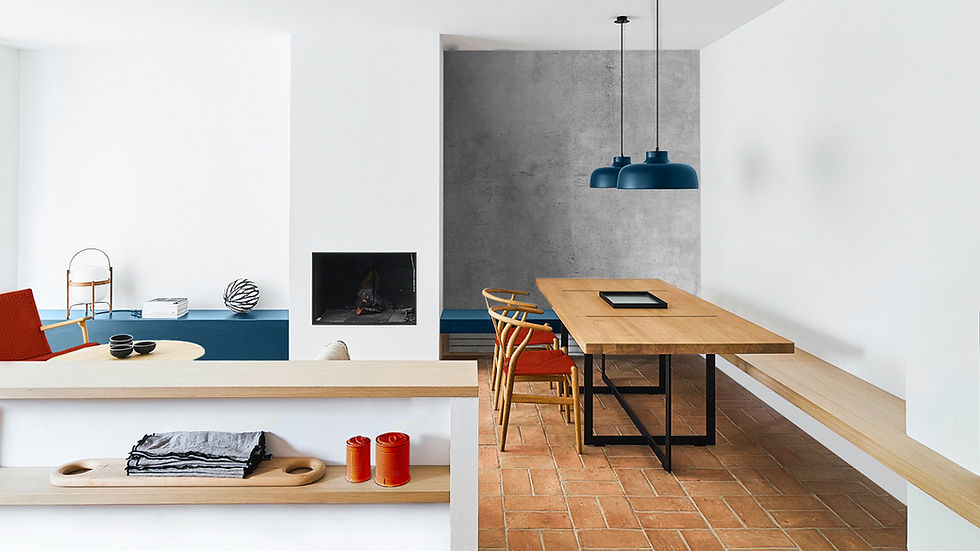Biophilic Design: Bringing Nature into Your Home
- Design touch24

- Jun 16, 2023
- 3 min read

Introduction:
In a fast-paced and technology-driven world, incorporating elements of nature into our living spaces has become more important than ever. Biophilic design is an innovative approach that seeks to reconnect us with the natural world by bringing nature into our homes. In this article, we will explore the concept of biophilic design and its numerous benefits. From incorporating plants and natural materials to embracing natural light and views, discover how you can create a harmonious and rejuvenating environment that nourishes both the body and mind.
Introduce Indoor Plants: One of the easiest ways to incorporate biophilic design is by adding indoor plants. Plants not only bring a touch of nature indoors but also improve air quality and create a calming atmosphere. Choose a variety of plants with different textures and sizes, and place them strategically throughout your home to create a vibrant and refreshing ambiance.
Embrace Natural Materials: Incorporating natural materials into your home adds warmth and authenticity. Opt for furniture and decor made from wood, stone, bamboo, or rattan. Use natural fabrics like cotton, linen, or jute for upholstery and curtains. The use of these materials creates a tactile experience and enhances the connection with nature.
Maximize Natural Light: Natural light has a transformative effect on our well-being. Maximize the amount of natural light in your home by keeping windows unobstructed and using light-filtering window treatments. Arrange your furniture to take advantage of natural light and create inviting spaces that bathe in the glow of the sun.
Incorporate Water Features: The soothing sound and movement of water can create a calming and peaceful atmosphere. Consider adding a small water fountain, a tabletop waterfall, or even an indoor pond. These water features not only enhance the visual appeal of your space but also provide a sense of tranquility and relaxation.
Create Views to the Outdoors: Design your home in a way that offers views of the surrounding nature. Whether it's a garden, a courtyard, or a scenic landscape, frame these views with large windows or glass doors. By connecting your indoor space with the outdoor environment, you can enjoy the beauty of nature from the comfort of your own home.
Incorporate Natural Patterns and Textures: Bring the beauty of nature indoors through patterns and textures inspired by the natural world. Consider using wallpaper or textiles with botanical prints, floral patterns, or organic motifs. Incorporate textured elements like stone or wood accents to add depth and visual interest to your space.
Engage the Senses: Biophilic design aims to engage all the senses. Use essential oils or natural scents to fill your home with refreshing aromas. Play soothing nature sounds or incorporate wind chimes for gentle melodies. By engaging multiple senses, you create a multisensory experience that further connects you with nature.
Design Functional Outdoor Spaces: Extend your living space outdoors by creating functional outdoor areas. Design a cozy patio, a serene garden, or a rooftop oasis where you can relax, dine, or engage in activities surrounded by nature. Incorporate comfortable seating, outdoor lighting, and natural elements to make your outdoor space inviting and enjoyable.
Encourage Natural Movement: Incorporate elements that encourage natural movement and exploration within your home. Create pathways that lead to different areas, incorporate nooks or alcoves for quiet retreats, or design a vertical garden that attracts the eye upward. By encouraging movement and exploration, you create a dynamic and engaging living environment.
Seek Balance and Harmony: Ultimately, biophilic design is about creating a balanced and harmonious living space that connects us with the natural world. Find a balance between natural elements and modern aesthetics, between openness and privacy, and between simplicity and complexity. Let nature inspire your design choices while staying true to your personal style and preferences.
Conclusion:
Biophilic design offers a transformative approach to interior design, emphasizing the importance of our connection with nature. By integrating natural elements, maximizing natural light, incorporating views of the outdoors, and engaging the senses, we can create living spaces that promote well-being, rejuvenation, and harmony. Embrace the beauty of biophilic design and bring the nurturing power of nature into your home.




Comments